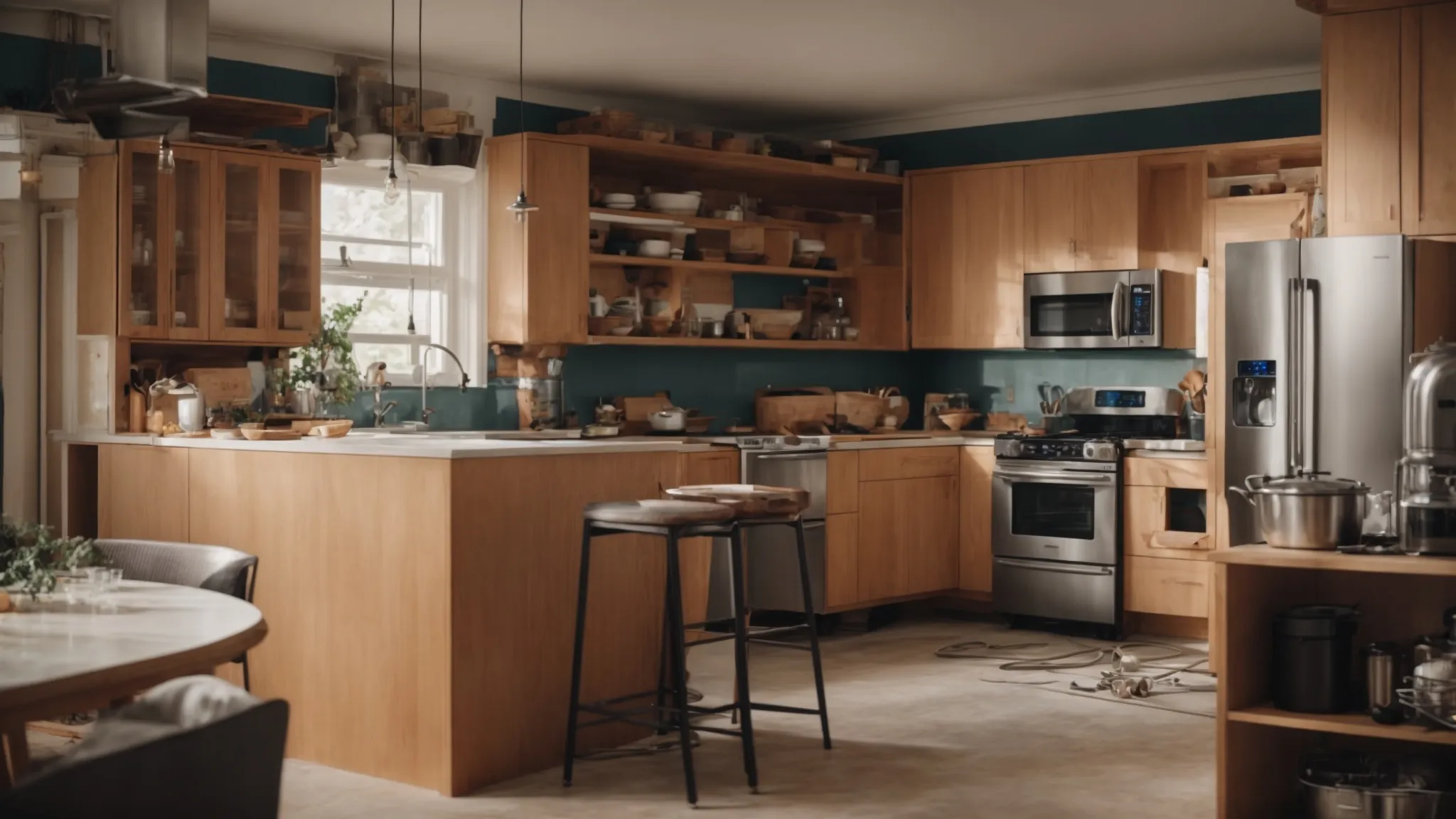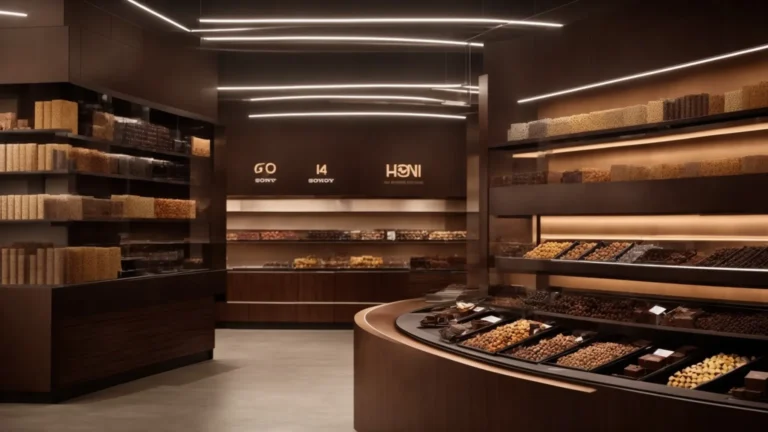Breaking Down the Cost of a Kitchen Remodel
Embarking on a home improvement journey can stir up a mix of excitement and anxiety, especially when it comes to revamping the heart of the home: the kitchen.
Whether dreaming of sipping morning coffee on a revamped patio or marveling at the allure of newly installed kitchen cabinets, the crux of the matter often boils down to numbers—specifically, what’s the impact on your wallet?
A savvy homeowner navigates the murky waters of expenses with tools like a kitchen cabinet refacing cost calculator, and by scrutinizing the terms of service laid out by contractors, much like carefully examining the fine print on a new bed purchase.
To equip you with the insights you need to transform your kitchen without breaking the bank, I’ve crafted a guide that demystifies the costs and unlocks clever saving strategies.
Stay tuned as we slice through the costs, from countertops to cooktops, to empower you in making informed decisions for your kitchen remodel.
Key Takeaways
- Kitchen Remodel Costs Vary Greatly From Essential Upgrades to Luxury Transformations, Impacting the Project’s Final Tally
- Careful Planning and Budget Management Are Crucial for Financing a Kitchen Remodeling Project Without Compromising the Desired Outcome
- Material Selection for Countertops, Cabinetry, and Flooring Significantly Influences the Total Renovation Cost, With Various Options Offering Different Price Points
- Securing Accurate Remodeling Quotes and Anticipating Potential Hidden Costs Are Essential for Maintaining a Realistic Budget
- Strategic Choices in a Kitchen Remodel Can Enhance Property Value and Offer a Favorable Return on Investment for Homeowners
Understanding the Basics of Kitchen Remodel Costs

Embarking on a kitchen remodel is akin to charting a course through unknown territories, where accurate expense calculation becomes your compass.
The trusty kitchen cost estimator serves as my initial go-to tool, guiding homeowners through the maze of budget determination with surprising precision.
Just as the selection of siding materials can transform the facade of a house or a well-manicured lawn can offset the dreariness of winter’s chill, so too does a crafted kitchen infuse warmth into a living space.
But as one contemplates revamping their culinary haven, the pivotal query isn’t just the upfront investment; it’s predicting how this venture scales from essential updates to a full-blown luxury transformation, all the while considering how elements like heat efficiency or bespoke carpentry impact the final tally.
Grasping these concepts is vital, as they represent the pillars that uphold the financial structure of any kitchen revitalization project.
Determining Your Kitchen Remodel Budget
Allocating funds for a kitchen remodel requires a fine balance, not unlike strategizing investment portfolios, where risks and rewards must be weighed with discernment. The financial blueprint for your project should take lessons from the careful planning that goes into bathroom renovations or bedroom redecorations, emphasizing both functionality and aesthetic appeal, while always keeping an eye on the overall value addition to your property.
My approach to honing in on that budget sweet spot involves a meticulous privacy policy of sorts, where clear-cut boundaries are established to prevent any unnecessary outflow of funds. This includes deciding whether to splurge on that state-of-the-art tap or to conserve resources for unforeseen circumstances, ensuring that every dollar spent enhances the heart of the home without undermining its financial footing.
Average Costs for a Basic vs. Luxury Kitchen Remodel
Pinning down the price point for a standard kitchen renovation, one might expect to allocate funds for quintessential elements such as a sturdy, mid-range refrigerator, base-level plumbing amendments, and straightforward countertop installation. The focus here lies in practicality and durability, ensuring that essentials are upgraded while avoiding extravagant expenses.
- Mid-range refrigerator: A balance between functionality and cost-efficiency
- Base-level plumbing: Essential work that aligns with a modest budget
- Straightforward countertop installation: Focus on material quality and resilience
On the flip side, envisioning a luxury kitchen introduces variables like designer refrigerators that hinge on cutting-edge technology, comprehensive plumbing overhaul possibly necessitating the expertise of a structural engineer, and high-end countertop choices that demand meticulous waterproofing. These selections reflect a broader ambition, transforming a kitchen into a statement of opulence and innovation where expense skews upward to match the grandeur of the envisioned space.
Key Factors That Affect Kitchen Remodeling Costs
Daring to dream of the perfect kitchen often leads to visions of glistening tiles beneath the ambient glow of a statement ceiling fan, yet the stark reality of cost quickly grounds such aspirations. Even in a bustling metropolis like Los Angeles, where home aesthetics are as diverse as its inhabitants, the choice of tile can make or break both the design ethos and the budget of a house remodel.
Within the walls of my home, as any professional remodeler would attest, factors like the degree of customization for a ceiling fan, the intricacy of tilework, and the intended functionality merge together to form the cost mosaic. It matters greatly whether the objective is to create a culinary theater adorned with the finest finishes or simply update an aging kitchen to reflect a more contemporary lifestyle.
Detailed Breakdown of Kitchen Remodeling Costs

Diving deeper into the anatomy of a kitchen remodel, understanding the cost implications of cabinetry and hardware becomes instrumental.
The foundation of any kitchen‘s functionality and accessibility hinges on these pivotal elements.
As I contract with clients, we carefully assess the choices of wood or alternative materials, which directly influence both aesthetics and pocketbook.
Countertop materials and installation expenses also weigh heavily in the financial equation, with a variety of options ranging from classic granite to modern composites.
As we navigate through flooring options, we confront a spectrum of prices, recognizing the durability and style each brings to the kitchen space.
Then, there’s the exciting yet daunting task of selecting appliances that align with your culinary needs and budget preferences – a balance of efficiency and luxury.
Lastly, a critical aspect not to be overlooked involves calculating the costs for lighting, as well as necessary electrical and plumbing work – the unseen yet vital systems that ensure a well-lit space and the smooth operation of everything from your sink to the air conditioning.
Together, these costs amount to more than just numbers; they represent the investment in your home’s future.
Cabinetry and Hardware Costs
Fiddling with the knobs of a kitchen renovation calculator, as any expert will opine, often springs forth the stark reality that cabinetry and hardware form a substantial chunk of renovation budgets. The data suggests that materials, finish, and hardware choices are like the bricks of this financial edifice; alter one and the room’s cost structure inevitably shifts.
Having conferred with many homeowners, I’ve observed that their unique preferences set the tone for the intricacy and expense of cabinetry. Pursuing premium hardware can bestow upon a kitchen an air of unparalleled sophistication, yet keen awareness of the budget‘s elasticity—tempered by expert recommendations—can prevent an aesthetic dream from turning into a financial quandary.
Countertop Material and Installation Expenses
Navigating the varied landscape of countertop materials can be as involved as retrofitting pantry spaces to accommodate new storage solutions. High-end options like engineered stone or natural marble may mirror the opulence of a well-appointed living room, yet they come with considerations such as increased weight, which could necessitate reinforcing the underlying cabinet structures and potentially the electrical wiring.
Installation of new countertops often involves more than simply laying down materials; it’s a process that sometimes uncovers hidden issues like water damage or the need for new molding to seamlessly integrate with existing structures. A keen eye for detail helps ensure that the transformation not only enhances the kitchen’s appeal but also fortifies its longevity.
| Material | Cost Range | Additional Considerations |
|---|---|---|
| Engineered Stone | $40 – $100 per sq ft | May require cabinet reinforcement |
| Granite | $75 – $200 per sq ft | Periodic sealing needed |
| Laminate | $25 – $50 per sq ft | Cost-effective, varied designs |
| Marble | $100 – $300 per sq ft | Elegant, prone to staining |
Flooring Options and Prices
My toolbox for remodeling often emphasizes flooring as it’s the stage upon which all kitchen furniture takes its stand. In providing clients with a realistic cost estimate, I take into account both the material prices and the installation complexity, which can escalate when integrating features like crown molding or intricate tile patterns that complement the overall aesthetic.
Adhering to a budget doesn’t preclude quality; on the contrary, it challenges me to uncover value without sacrificing style or durability. My experience has taught me that whether opting for luxurious hardwood or practical laminate, it’s the judicious choice of materials and design that establishes the kitchen‘s foundation, both visually and financially.
Appliances: Choosing the Best for Your Budget
Selecting appliances for a kitchen remodel must marry functionality with financial savvy. An architect designing a grand vision with sweeping spaces might envisage a kitchen punctuated by a chef-grade range and an elegant refrigerator discreetly tucked behind custom cabinetry; however, real-world budget constraints often require me to source appliances that deliver performance without the prestige price tag, much as choosing a durable rain gutter system over ornate but costly alternatives.
The labyrinth of the supply chain can greatly affect appliance costs, a reality not unlike tracking the journey of materials for creating the perfect plaster finish or finding the ideal fireplace insert. Following recent fluctuations, I’ve learned to guide clients toward high-value appliances that promise reliability and efficiency:
- Evaluating energy-efficient models that offer long-term savings.
- Seeking promotional deals from reputable manufacturers.
- Considering the integration of appliances to complement the kitchen design without compromising on quality.
Lighting, Electrical, and Plumbing Work Costs
The labyrinth of costs associated with lighting, electrical, and plumbing can cause anyone to wince, as they are swayed by market rates and the ever-fluctuating price of skilled labor. Securing the expertise of a general contractor can alleviate some of the stress related to these expenses, but it’s the wage bracket within your zip code that often sets the baseline for your project’s financial framework.
In this intricate dance of numbers, I’ve found that creating an aesthetic appeal through lighting design or efficiently routing new plumbing can sometimes incur additional hours, thus affecting the bottom line. Ensuring that these crucial elements don’t stain the fabric of my budget requires diligent oversight and a strategic partnership with tradespeople who value precision as much as I do.
Saving Money on Your Kitchen Remodel

In the thick of grappling with the complexities of a kitchen remodel, my clients often find themselves searching for the sweet spots where they can trim the budget without sacrificing their vision.
With a clever reshuffle of the floor plan or the judicious selection of materials, notable savings can emerge.
For example, the cost disparity between a high-end microwave oven and a model with fewer bells but no less whistles can be profound, akin to choosing a more affordable yet efficient dishwasher.
I guide those I work with towards cost-effective alternatives that still resonate with their aesthetic and functional expectations.
I also offer insights on labor expenses, revealing techniques to keep these costs in check while ensuring the work meets high-quality standards.
Embracing certain aspects of the remodeling process oneself, when privacy isn’t a concern and skills suffice, can lead to substantial savings, engaging homeowners in a rewarding journey of transformation and personal accomplishment.
Cost-Effective Alternatives to Expensive Materials
In my years of consulting on kitchen renovations here in Houston, I’ve unearthed a trove of materials that mirror the allure of their costly counterparts, without wreaking havoc on your finances. The workflow of a project need not be disrupted by exorbitant purchases when options like luxury vinyl tile can give you the hardwood look for less, and modern laminate countertops achieve a high-end stone appearance without the heavy price tag.
Accurate information can serve as a powerful estimator in your quest to balance quality and expense. For example, choosing prefabricated cabinetry over custom-built units can yield significant savings, and the utilization of open shelving, as opposed to wall-to-wall cabinets, not only cuts costs but can also give your kitchen an airy, modern vibe:
| Cost-Saving Material | Traditional Material | Estimated Savings |
|---|---|---|
| Luxury Vinyl Tile | Hardwood | 25-30% |
| Laminate Countertops | Stone Countertops | 50-60% |
| Prefabricated Cabinetry | Custom Cabinetry | 20-40% |
| Open Shelving | Full Cabinetry | 60-70% |
Tips for Saving on Labor Costs
As I converse with clients about estimated kitchen renovation costs, I stress the importance of being judicious with their labor investments. Meticulous planning and clear communication can mitigate costs similar to a carefully budgeted bathroom renovation. Prioritizing tasks that require specialized skills – such as precise cabinetry installation or electrical work – ensures that your money is allocated to areas where professional expertise is truly necessary.
Oftentimes, my advice centers on helping homeowners understand when it might be advantageous to contribute their own labor to the project. While major structural changes are best left to the professionals, painting or undertaking demolition work can save a substantial amount of money. This approach requires a candid assessment of one’s abilities and time, safeguarding the integrity of your property while keeping expenses in check.
- Focus labor spending on specialized tasks to optimize budget use.
- Consider DIY approaches for non-structural work to maintain property integrity and save money.
When to Opt for DIY in Your Kitchen Remodel
I’ve always believed that with a bit of elbow grease and determination, the DIY route can offer substantial savings for a kitchen remodel, particularly when it comes to less technical tasks. Tackling the demolition phase, for example, is something energetic homeowners can undertake themselves, provided all rights reserved precautions and necessary safety measures are strictly followed. Not only does this help save on labor costs, but it also allows you to handle the removal of specific features gently, like that bamboo door you’ve grown fond of and wish to repurpose.
Then there’s the procurement of materials: doing the legwork to source items such as granite countertop remnants can result in significant cost reduction. Whether it’s visiting a local quarry or scouting secondhand shops, personally hunting for those perfect pieces injects a touch of custom flair into your kitchen refresh while keeping budgets intact:
- Embark on the demolition phase to cut initial labor costs.
- Search for granite remnants and other materials to reduce expenses.
Hidden Costs in Kitchen Remodeling Projects

Amid the excitement of orchestrating a kitchen redesign, it’s tempting to envision a new stove gleaming in its place and countertops waiting to be adorned.
Yet, seasoned by numerous projects, I always brace for the hidden layers of expense that might lurk beneath the surface.
The best-laid plans could unravel without a proactive strategy for unexpected costs that spring up during construction.
Drawing from an arsenal of experience, I wield my kitchen renovation cost calculator, not merely as a tool, but as part of a broader cost management approach.
This serves to prepare for the often-overlooked financial implications of permits and inspections—the concrete steps essential to ensuring a smooth transition from dream to reality.
Dealing With Unexpected Costs
In my experience, a furnace on the brink can be a source of unexpected expenditure, revealing itself only when the walls are stripped back and the true condition of the heating system comes to light. Ensuring your heat pump or furnace is evaluated early in the planning phase can save you from the chill of unforeseen high costs, acquiring particular weight if you’re looking to enhance natural daylight with larger windows or skylights.
Among the surprise outlays are the appliances, especially when an oven that has stood the test of time suddenly shows signs of surrender amidst renovation. I reckon one always has to anticipate potential replacements or upgrades, not to mention the prospect of discovering that the beautiful wood flooring might need more than just refinishing—a reality that could necessitate a complete overhaul.
Budgeting for Permits and Inspections
In the intricate ballet of remodeling, smart budgeting for permits and inspections is akin to laying the proper foundation with pavers—skipping this step might result in wobbly outcomes. As I craft an estimate for kitchen cabinets or advise on materials like steel reinforcements for countertops, the inclusion of permit and inspection fees becomes a non-negotiable line item.
Per square foot, the costs can rise unexpectedly, reminiscent of the variability in pricing of vinyl siding or other materials. Anticipating these expenses ensures that my blades are sharpened to carve out an accurate and encompassing financial picture for my clients, leaving no stone unturned.
- Always factor in the cost of permits and inspections early in the remodeling process.
- Consider permit fees as foundational expenses, much like the pavers for a stable patio.
- Account for material-specific requirements such as steel reinforcements within budget projections.
- Stay mindful of the changing per foot costs impacting the total expense outlook.
- Include assessments for needs like vinyl siding as part of the comprehensive estimate.
Choosing the Right Contractor for Your Kitchen Remodel

Selecting the perfect contractor is the linchpin in the complex mechanics of a kitchen remodel—a choice with as much impact on the outcome as the kitchen renovation cost estimator has on your budget.
To ensure the groundwork for your culinary transformation is as robust as a new fence, I wholeheartedly advocate investing time in obtaining precise remodeling quotes.
The key is to peer beyond the glossy advertising of contractors’ past achievements and discern the substance of their track record.
Just as a strong brand signifies more than a logo, an experienced contractor brings a depth of expertise that goes beyond the surface.
This proficiency is essential, not only in kitchens but also in a bathroom remodel, where the intricacy of plumbing and tile work can test the mettle of any professional.
Navigating this decision with clarity and insight will fundamentally shape the efficiency, aesthetics, and enjoyment of your renovated space.
How to Get Accurate Remodeling Quotes
Gathering accurate remodeling quotes is a pivotal step in any kitchen renovation, acting as a safeguard against fluctuating project costs that could impact both your budget and potential return on investment. I’ve found that starting with a precise list of needs – whether it’s stock cabinetry or custom designs, basic laminate countertops or lavish granite – sets the stage for contractors to provide you with realistic price estimates.
When I solicit quotes, I ensure clarity by providing detailed specifications and measurements, a move that not only aids in mitigating any ambiguity but also steers the conversation toward a clearer understanding of material costs, such as those for an asphalt shingle counter option. Aligning expectations upfront fosters a transparent pricing structure and reduces the likelihood of encountering unexpected expenses down the line:
| Material/Task | Estimated Cost | Potential for Return on Investment |
|---|---|---|
| Stock Cabinetry | $5,000 – $10,000 | Moderate |
| Granite Countertops | $2,000 – $5,000 | High |
| Laminate Flooring | $1,500 – $3,000 | Low to Moderate |
| Asphalt Shingle Counter | $500 – $1,000 | Low |
| Appliance Upgrade | $3,000 – $8,000 | High |
The Importance of Choosing Experienced Professionals
My sense of trust heightens when I hand over the reins of my kitchen remodel to a professional electrician. It’s their seasoned hands and keen understanding of Denver‘s construction codes that ensure a smooth, safe installation, weaving electrical work through walls like a surgeon’s suture, turning what could be a tangled web into a sleek, hidden network behind the splendor of new cabinetry.
Meanwhile, the specter of asbestos, lurking in older homes like a buried relic awaiting disturbance, is why I rely on a battalion of experts, who can courageously tackle such challenges. Their expertise means the difference between an undisturbed driveway and a potential hazardous zone, and their precision allows me to receive a kitchen renovation estimate that isn’t just a guess but a dependable roadmap to achieving the kitchen of my dreams.
Planning Your Kitchen Remodel Timeline

Embarking on kitchen remodeling ventures, I’ve observed firsthand that the timeline from concept to completion is not as straightforward as one may initially perceive.
It’s as complex and layered as the veining in a slab of fine marble or the plans laid out in a packed garage waiting for a transformation.
My accumulated knowledge tells me that understanding how long a kitchen remodel truly takes demands a grasp of every detailed step – from demolishing old cabinetry to the joyous day you take your first shower in a newly minted adjacent bathroom.
Equally, planning for downtime and delays is not just advisable, it’s an integral part of the process.
Whether it’s securing that sought-after marble countertop or navigating through the unexpected discovery of plumbing issues behind kitchen walls, a clear and flexible timeline ensures that I maintain order amidst the creativity and chaos of renovation.
How Long Does a Kitchen Remodel Really Take?
The duration of a kitchen remodel is much like the meticulous work required to craft a fine piece of metalwork; it depends on the complexity of the project and the space involved. Frequently, clients in Atlanta ask me for timelines and my response hinges on the specifics: a straightforward update might wrap up in a month or two, whereas extensive transformations that address structural and water systems can span several months.
Indeed, factoring in the cost of labor and materials, a typical kitchen remodel in Atlanta’s bustling market could take anywhere from four to eight weeks for minor renovations, to upwards of twelve weeks for a high-end overhaul. Delays are not uncommon, especially when specialty items or custom-built pieces play a key role in the space‘s metamorphosis, so I always encourage building in a buffer to account for the unexpected.
Planning for Downtime and Delays
When sketching out a timeframe for a kitchen remodel, I always consider the potential for pause in the project’s momentum. Whether it’s an average delay in the shipping of that designer wine cooler I’ve set my sights on, or unexpected backorders logged in a supplier’s database, I reserve a cache of time—and sometimes even cash—to ensure these hiccups don’t entirely derail our progress.
Navigating the complexities that inevitably arise, such as the integration of a new cooktop that might necessitate additional electrical work, teaches me patience and flexibility. Accepting that some delays are part of the process allows me to keep clients informed and manage expectations, while keeping our eyes on the prize—a beautifully remodeled kitchen that brings joy and functionality to a home.
Financing Your Kitchen Remodel

Transitioning from the initial rush of choosing ceramic tiles or a slate backsplash for your kitchen remodel, the reality of financing such a venture comes to the fore—a shift in focus as necessary as deciding between butcher block countertops or a new deck extension off the living room.
Exploring financing options for your project unveils a plethora of pathways to turn your envisioned sanctuary into a tangible space without overwhelming your financial equilibrium.
Integrating budgeting tips for a smooth remodel into my overall strategy is not only about cost management but about creating certainty in a process that can, at times, be as fluid as the veining in a marble countertop.
Navigating through loan types, interest rates, repayment schedules, and the potential for refinancing helps ensure that your kitchen‘s transformation supports your lifestyle without undermining your financial foundations.
Exploring Financing Options for Your Project
Exploring financing options for your project can be as multifaceted as deciding on a metal roof versus traditional shingles. It’s about evaluating which lending avenues align with your remodel’s expense and will integrate smoothly with your current cost of living without creating financial strain.
Often, while browsing through houzz for inspiration or comparing prices of a garage door, I’ve discovered hidden financing gems that offer competitive rates and terms tailored to home improvement projects. It’s about digging deeper to find solutions that cover costs effectively, allowing peace of mind as you transform your kitchen into a masterpiece of form and function.
Budgeting Tips for a Smooth Remodel
As I weave through the intricacies of allocating funds for kitchen enhancements, incorporating home automation elements requires a strategic approach to my financial planning. I’m mindful to prioritize functional upgrades like advanced ventilation systems, especially with New York City‘s compact living spaces, ensuring my budget remains robust enough to embrace both innovation and necessity.
Utilizing tools like the Home Depot kitchen estimator, I anchor my budgeting process in grounded numbers, taking care not to let the allure of aesthetic upgrades eclipse the essential groundwork. I keep a vigilant watch on my floor plans and pricing, ensuring that my financial footprint aligns seamlessly with every envisioned kitchen detail.
Maximizing the Return on Your Kitchen Remodel Investment

Investing in a kitchen remodel can be a thrilling pursuit, yet it’s the shrewd evaluation of this renovation‘s return on investment (ROI) that transforms those initial sparks of excitement into long-term gratification.
With a keen eye on the market, I’ve come to understand which projects sing with potential for profit.
Strategic upgrades like a fresh coat of neutral-toned paint, modern light fixtures to brighten the space, or even an attic renovation for added living area can attract buyers and bolster resale value.
Equally, choosing energy-efficient window installations marries form and function, further increasing a home’s allure.
It’s this blend of astute choices I make for my kitchen spaces that elevates the everyday into a financial win, ensuring the endeavors I undertake today have a resounding impact on my home’s value tomorrow.
Kitchen Remodel Projects With the Highest ROI
As I embark on kitchen remodels with an eye for increasing property value, I often advise clients to consider the impact of high-ROI projects. Strategically replacing outdated chairs with modern, ergonomic models can significantly uplift a dining area’s appeal, thereby aligning with community expectations for comfort and style while also increasing the perceived value of the home.
Assessing the potential tax benefits and ROI of adding luxurious amenities such as a built-in hot tub can be a game-changer for clients seeking to set their property apart. Investments in high-quality materials, like energy-efficient glass paneled cabinets, not only contribute to a sleek, contemporary kitchen aesthetic but also resonate well with potential buyers looking for a blend of sustainability and elegance.
- Replace outdated chairs with modern, ergonomic alternatives
- Evaluate the inclusion of a built-in hot tub for luxury appeal
- Invest in energy-efficient glass paneled cabinets for sustainability
How Your Remodel Affects Home Value
The decision to integrate a plush quartz countertop into the heart of my kitchen not only mirrors the latest in interior design trends but also positions my home favorably within the landscape of real estate offerings. A modern and durable quartz countertop not only draws the admiration of guests but can be a decisive factor for potential buyers, enhancing the overall home value with its timeless appeal.
By redesigning the laundry area to incorporate an elegant, deep basin sink, I’ve noticed a significant elevation in both the functionality and the marketability of my home. A well-thought-out laundry space that marries utility with sleek design broadcasts a message of considered luxury, potentially tipping the scales in my favor when it comes time to gauge the return on my investment through the lens of home valuation.
Conclusion
Breaking down the cost of a kitchen remodel illuminates the complex interplay between budgeting and personal preferences, guiding homeowners through a rewarding but potentially expensive venture.
By carefully examining each aspect, from cabinetry to labor costs, individuals can make informed financial decisions that balance their aesthetic desires with practical considerations.
Anticipating hidden costs and understanding the factors influencing expenses enable a disciplined approach to renovation, ensuring that surprise charges don’t derail the project.
Ultimately, a well-planned budget becomes the foundation for a kitchen transformation that enhances home value while reflecting the unique lifestyle of the owner.





